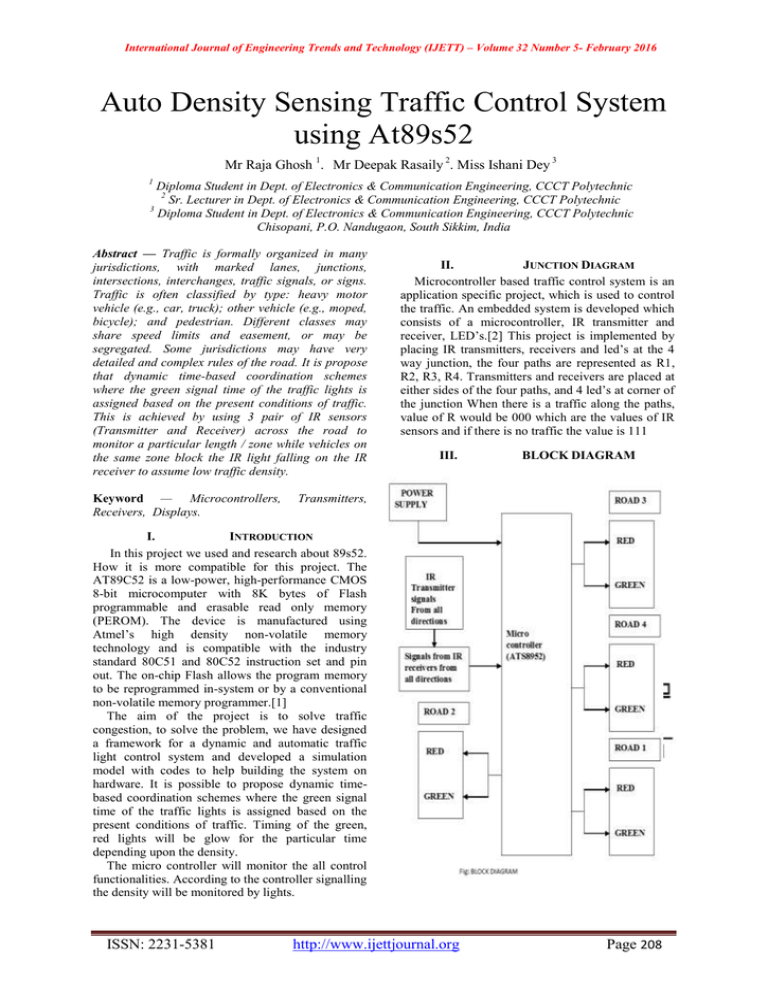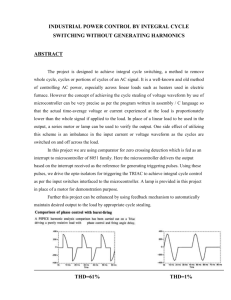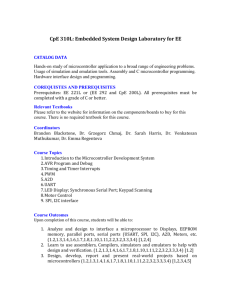Document 12917256
advertisement

International Journal of Engineering Trends and Technology (IJETT) – Volume 32 Number 5- February 2016 Auto Density Sensing Traffic Control System using At89s52 Mr Raja Ghosh 1. Mr Deepak Rasaily 2. Miss Ishani Dey 3 1 Diploma Student in Dept. of Electronics & Communication Engineering, CCCT Polytechnic 2 Sr. Lecturer in Dept. of Electronics & Communication Engineering, CCCT Polytechnic 3 Diploma Student in Dept. of Electronics & Communication Engineering, CCCT Polytechnic Chisopani, P.O. Nandugaon, South Sikkim, India Abstract — Traffic is formally organized in many jurisdictions, with marked lanes, junctions, intersections, interchanges, traffic signals, or signs. Traffic is often classified by type: heavy motor vehicle (e.g., car, truck); other vehicle (e.g., moped, bicycle); and pedestrian. Different classes may share speed limits and easement, or may be segregated. Some jurisdictions may have very detailed and complex rules of the road. It is propose that dynamic time-based coordination schemes where the green signal time of the traffic lights is assigned based on the present conditions of traffic. This is achieved by using 3 pair of IR sensors (Transmitter and Receiver) across the road to monitor a particular length / zone while vehicles on the same zone block the IR light falling on the IR receiver to assume low traffic density. Keyword — Microcontrollers, Receivers, Displays. II. JUNCTION DIAGRAM Microcontroller based traffic control system is an application specific project, which is used to control the traffic. An embedded system is developed which consists of a microcontroller, IR transmitter and receiver, LED‟s.[2] This project is implemented by placing IR transmitters, receivers and led‟s at the 4 way junction, the four paths are represented as R1, R2, R3, R4. Transmitters and receivers are placed at either sides of the four paths, and 4 led‟s at corner of the junction When there is a traffic along the paths, value of R would be 000 which are the values of IR sensors and if there is no traffic the value is 111 III. BLOCK DIAGRAM Transmitters, I. INTRODUCTION In this project we used and research about 89s52. How it is more compatible for this project. The AT89C52 is a low-power, high-performance CMOS 8-bit microcomputer with 8K bytes of Flash programmable and erasable read only memory (PEROM). The device is manufactured using Atmel‟s high density non-volatile memory technology and is compatible with the industry standard 80C51 and 80C52 instruction set and pin out. The on-chip Flash allows the program memory to be reprogrammed in-system or by a conventional non-volatile memory programmer.[1] The aim of the project is to solve traffic congestion, to solve the problem, we have designed a framework for a dynamic and automatic traffic light control system and developed a simulation model with codes to help building the system on hardware. It is possible to propose dynamic timebased coordination schemes where the green signal time of the traffic lights is assigned based on the present conditions of traffic. Timing of the green, red lights will be glow for the particular time depending upon the density. The micro controller will monitor the all control functionalities. According to the controller signalling the density will be monitored by lights. ISSN: 2231-5381 http://www.ijettjournal.org Page 208 International Journal of Engineering Trends and Technology (IJETT) – Volume 32 Number 5- February 2016 A. BLOCK DISCRIPTION The main objective of this project is to control the traffic depending upon the density .As there is much time wastage with the traffic lights which involves the Time, we are designing the new system which controls the traffic depending upon the density.[4][5]Here we place IR transmitter and the IR receivers at both ends of the roads. Whenever the vehicles pass in-between them the continuity will be lost. Hence the microcontroller senses the density is high. Then the microcontroller will be making the light (green) to be glow much time at the place where the traffic is high. The system uses a compact circuitry build around flash version of AT89S52 Microcontroller with a non-volatile memory. Programs will be developed in EMBEDDED C language. FLASH MAGIC is used for loading of programs into microcontroller. would normally remain high and would go low when it detects the signal (the obstacle). IV. CIRCUIT DIAGRAM & DISCRIPTION C. POWER SUPPLY(5V) B. IR TRANSMITTER & RECIEVER The purpose of the transmitter is to transform the information we want to send into a signal that can be propagated by the channel. In the case of our wired copper channel, this means we want the information to be transformed into a modulated voltage level, something like the pulse train. For a wireless channel, however, the transmitter needs to encode the information onto an EM wave that can be easily propagated. B.A IR TRANSMITTER The IR transmitter part consists of an Infra-red light emitting diode that can capable of sending modulated data within infra-red band. To match the receiver frequency the data is modulated at 38.7 KHZ by configuring 555 timer at a stable mode of operation, which generates frequency using the components R2 and C2 as shown in above fig. This frequency can be varied over a long range just by varying the present R1 and C1. B.B IR RECIEVER The IR receiver consists of TSOP 1738 module which is a simple yet effective IR proximity sensor built around the TSOP 1738 module. The TSOP module is commonly found at the receiving end of an IR remote control system; e.g., in TVs, CD players etc.[3] These modules require the incoming data to be modulated at a particular frequency and would ignore any other IR signals. It is also immune to ambient IR light, so one can easily use these sensors Outdoor or under heavily conditions. Such modules are available for different carrier frequencies from 32 kHz to 42 kHz. In this particular proximity sensor, we will be generating a constant stream of square wave signal using IC555 centered at 38 kHz and would use it to drive an IR led. So whenever this signal bounces off the obstacles, the receiver would detect it and change its output. Since the TSOP 1738 module works in the active-low configuration, its output ISSN: 2231-5381 The schematic diagram gives the basic hardware connections used in the project. Beginning from the power supply the secondary of the step-down transformer wires are given to the two ends (2, 4) of bridge rectifier which is having the four diodes in the bridge format. The other two ends 1, 3)are connected to the input(pin 1) and output pin 3 of the 7805 regulator and pin no 2 is connected to ground as shown in schematic diagram. The 1000 micro farad capacitor is connected in between the bridge rectifier and regulator to eliminate the ac ripples presented in the rectified output. The 100 micro farad capacitor is used to eliminate the noise at regulator output. Now 5V is available at the pin no 3 of regulator and connected to pin no 40 of micro controller.[6] IR TRASMITTER & RECIEVER 1) IR TRANSMITTER: The IR LED is arranged with a resistor, in such a way that Vcc is applied to the positive terminal of the IR LED.[7] These are connected to the port 1 of the microcontroller. http://www.ijettjournal.org Page 209 International Journal of Engineering Trends and Technology (IJETT) – Volume 32 Number 5- February 2016 2) IR RECIEVER: The IR receivers are arranged with the transistor logic as shown in the diagram. The two transistors are connected in such a manner that collector terminal is connected to the base terminal of the other. The photo diode is connected to the base of the transistor along with the combination of the resistor. The IR Receivers are connected to the port 2 P2.0, P2.1, P2.2, P2.3 pins of the microcontroller. 3) MICROCONTROLER: The 8051 micro controller consists 40 pins and every pin has its own functionality as shown in the schematic diagram. The port 0 is having the pull up resistor which is having eight 10K resistors in parallel each connected to the each pin of it. The AT89S52 is a low-power, high-performance CMOS 8-bit microcontroller with 8K bytes of insystem programmable Flash memory. The device is manufactured using Atmel‟s high-density nonvolatile memory technology and is compatible with the industry-standard 80C51 instruction set and pin out. The on-chip Flash allows the program memory to be reprogrammed in-system or by a conventional non-volatile memory pro-grammar. By combining a versatile 8-bit CPU with in-system programmable Flash on a monolithic chip, the Atmel AT89S52 is a powerful microcontroller which provides a highlyflexible and cost-effective solution to many embedded control applications. The AT89S52 provides the following standard features: 8K bytes of Flash, 256 bytes of RAM, 32 I/O lines, Watchdog timer, two data pointers, three 16-bit timer/counters, a six-vector two-level interrupt architecture, a full duplex serial port, on-chip oscillator, and clock circuitry. In addition, the AT89S52 is designed with static logic for operation down to zero frequency and supports two software selectable power saving modes. The Idle Mode stops the CPU while allowing the RAM, timer/counters, serial port, and interrupt system to continue functioning. The Power-down mode saves the RAM con-tents but freezes the oscillator, disabling all other chip functions until the next interrupt or hardware reset. 4) CIRCUIT DISCRIPTION: In this project we required operating voltage for Microcontroller 89C51 is 5V. Hence the 5V D.C. power supply is ISSN: 2231-5381 needed for the IC‟s. This regulated 5V is generated by stepping down the voltage from 230V to 18V now the step downed A.C. voltage is being rectified by the Bridge Rectifier using 1N4007 diodes. The rectified A.C. voltage is now filtered using a „C‟ filter. Now the rectified, filtered D.C. voltage is fed to the Voltage Regulator. This voltage regulator provides/allows us to have a Regulated constant Voltage which is of +5V. The rectified; filtered and regulated voltage is again filtered for ripples using an electrolytic capacitor 100μF. Now the output from this section is fed to 40th pin of 89C51 microcontroller to supply operating voltage. The microcontroller 89C51 with Pull up resistors at Port0 and crystal oscillator of 11.0592 MHz crystal in conjunction with couple of 30-33pf capacitors is placed at 18th & 19th pins of 89s52 to make it work (execute) properly. [8] One of the main problems in our city‟s is traffic, this project proposed new solution to traffic control. The main design accept of this project is to control the traffic automatically and adding human inelegancy to that automatic controller. "Four-way" intersection is the most common configuration for roads that cross each other, and the most basic type. If signals do not control a 4-way intersection, signs or other features are typically used to control movements and make clear priorities. For IR communication we are using an IR transmitter and IR receiver. Here IR LED will acts as a transmitter. As we know microcontroller having inbuilt I/O ports and we are interfacing IR receivers to those I/O ports. For controlling of traffic we are using red, green and yellow colour LED‟s. These LED‟s are connected to different I/O ports of microcontroller. When there is a more traffic microcontroller gives signal to green LED and it will glow. So by using this project we can control the traffic automatically like a human being. D. SOFTWARE REQUIREMENT *Keil software for C programming *Proteus for schematic design http://www.ijettjournal.org Page 210 International Journal of Engineering Trends and Technology (IJETT) – Volume 32 Number 5- February 2016 E. RESULT: This project is mainly designed to reduce traffic problems, i.e. in general the four sides of the road at a signal point are controlled at regular intervals of time with a certain time delay. But in order to reduce the time at one side of the signal point with respect to the other side where there is more traffic we use IR sensors. It mainly consists of a microcontroller. IR transmitter placed nearer to the signal point and when it detects more density of traffic at any side it and it transmits signal to the receiver. The receiver receives this signal to the microcontroller. F. ADVANTAGES: A modernised way of controlling traffic. Number of road accidents can be reduced to a large extent. Easy traffic regulation in busy cities such as Metro cities, mega cities etc.. Help the traffic police in easy control of traffic G. FUTURE SCOPE: In future this system can be used to inform people about the condition of traffic at different places. This technique allows the operator to gather the recorded data from a far end to his home computer without going there. Based on the technology studied it is possible to develop cost effective, weather resistant products that have the potential for more sophisticated applications, including vehicle speed measurement and length classification. No. of passing vehicle in the fixed time slot on the road decide the density range of traffics and on the basis of vehicle count microcontroller decide the traffic light delays for next recording interval. The recorded data can be downloaded to the computer through communication between microcontroller and the computer. The Administrator sitting on computer can command system (microcontroller) to download recorded data, update light delays, erase memory, etc. Thus administrator on a central station computer can access traffic conditions on any approachable traffic lights and nearby roads to reduce traffic congestions to an extent. In future this system can be used to inform people about different places traffic condition. This can be done through RADIO. Data transfer between the microcontroller and computer can also be done through telephone network, data call activated SIM This technique allows the operator to gather the recorded data from a far end to his home computer without going there. • Traffic lights can be increased to N number and traffic light control can be done for whole city by sitting on a single place. • In ambulance system, the data of the patient in the ambulance can be sent to the Hospitals via GSM technology. Thus, it can provide early and fast treatment of the patient. ISSN: 2231-5381 V. CONCLUSIONS My project has been successfully designed and tested. Integrating features of all the hardware components used have developed it. Presence of every module has been reasoned out and placed carefully thus contributing to the best working of the unit. Secondly, using highly advanced IC‟s and with the help of growing technology the project has been successfully implemented. In this paper we have studied the optimization of traffic light controller in a City using IR sensors and microcontroller By using this system configuration we try to reduce the possibilities of traffic jams, caused by traffic lights. No. of passing vehicle in the fixed time slot on the road decide the density range of traffic and on the basis of vehicle count microcontroller decide the traffic light delays for next recording interval. REFERENCES [1] [2] [3] [4] [5] [6] [7] [8] [9] [10] D.Manoj “Density Based Traffic Control System” electrical & electronics engineering Department mahatma Gandhi institute of technology Chaitanya Bharathi P.O., Gandipet, Hyderabad – 500 075 2012 Promila Sinhmar “Intelligent Traffic Light and Density Control Using Ir Sensors and Microcontroller” Rawal Institute of Engineering And Technology Zakopur, Faridabad- Email: promila.sinhmar@gmail. B. Prashanth kumar, b. Karthik “ micro controller based traffic light controller”, Department of Electrical & Electronics Engineering gokaraju rangaraju institute of engineering & technology, 2011 Sachin Jaiswal*, Tushar Agarwal*, Akanksha Singh*and Lakshita* ” Intelligent Traffic Control Unit”, *Department of Electronics and Communication Engineering, Bharati Vidyapeeth‟s College of Engineering, Paschim Vihar, New Delhi-110063 Rijurekhasen, Andrew Cross, adityavashistha, Venkata N. Padmanabhan, Edward Cutrell, and William Thies “Accurate Speed and Density Measurement for Road Traffic in India” IIT Bombay Cihan Karakuzu. “Fuzzy logic based smart traffic light simulator design and hardware implementation”. Kocaeli University, Engineering Faculty, Electronics Multiple Traffic Control Using Wireless Sensor and Density Measuring Camera Amrita Rai and Govind Singh Patel. Sensors & Transducers Journal Vol. 94, Issue 7, July 2008, pp. 126-132. “Highway traffic model-based density estimation”-IEEE paper by Morarescu, Nancy Univ., France, published in American Control Conference (ACC), 2011. Musa Mohd Mokji and Syed Abd. Rahman Syed Abu Bakar, “Directional Image Construction Based on Wavelet Transform for Fingerprint Classification and Matching”, National Conference on Computer Graphics and Multimedia, pp. 331 – 335, 2002. ."Digital RF Memories", Journal of Electronic Defense Supplement, pp. 19-20, January 1994. http://www.ijettjournal.org Page 211 International Journal of Engineering Trends and Technology (IJETT) – Volume 32 Number 5- February 2016 Technology, Govt. of Sikkim prior to lecturer in C.C.C.T. his area of interest are PLC and Robotics, Microcontroller, Microprocessor and Digital Signal Processing. AUTHORS: 1. 2. RAJA GHOSH is presently student Diploma of Electronics & Communication Engineering at Centre for Computers and Communication Technology, Chisopani South Sikkim, India. He is join in 2013 batch for 3yr Diploma program. He is presently pursuing final year student in C.C.C.T completing his diploma till June 2016. DEEPAK RASAILY is presently associated with the department of Electronics & Communication at Centre for Computers and Communication Technology, Chisopani, South Sikkim, India as a Senior Lecturer since 2003 to till date. He is ME-Scholar at National Institute of Technical Teachers Training & Research, Chandigarh, India. He worked as Project scientist in the department of Science and ISSN: 2231-5381 3. ISHANI DEY is presently student Diploma of Electronics & Communication Engineering at Centre for Computers and Communication Technology, Chisopani South Sikkim, India. She is join in 2013 batch for 3yr Diploma program. She is presently pursuing final year student in C.C.C.T completing his diploma till June 2016. http://www.ijettjournal.org Page 212







